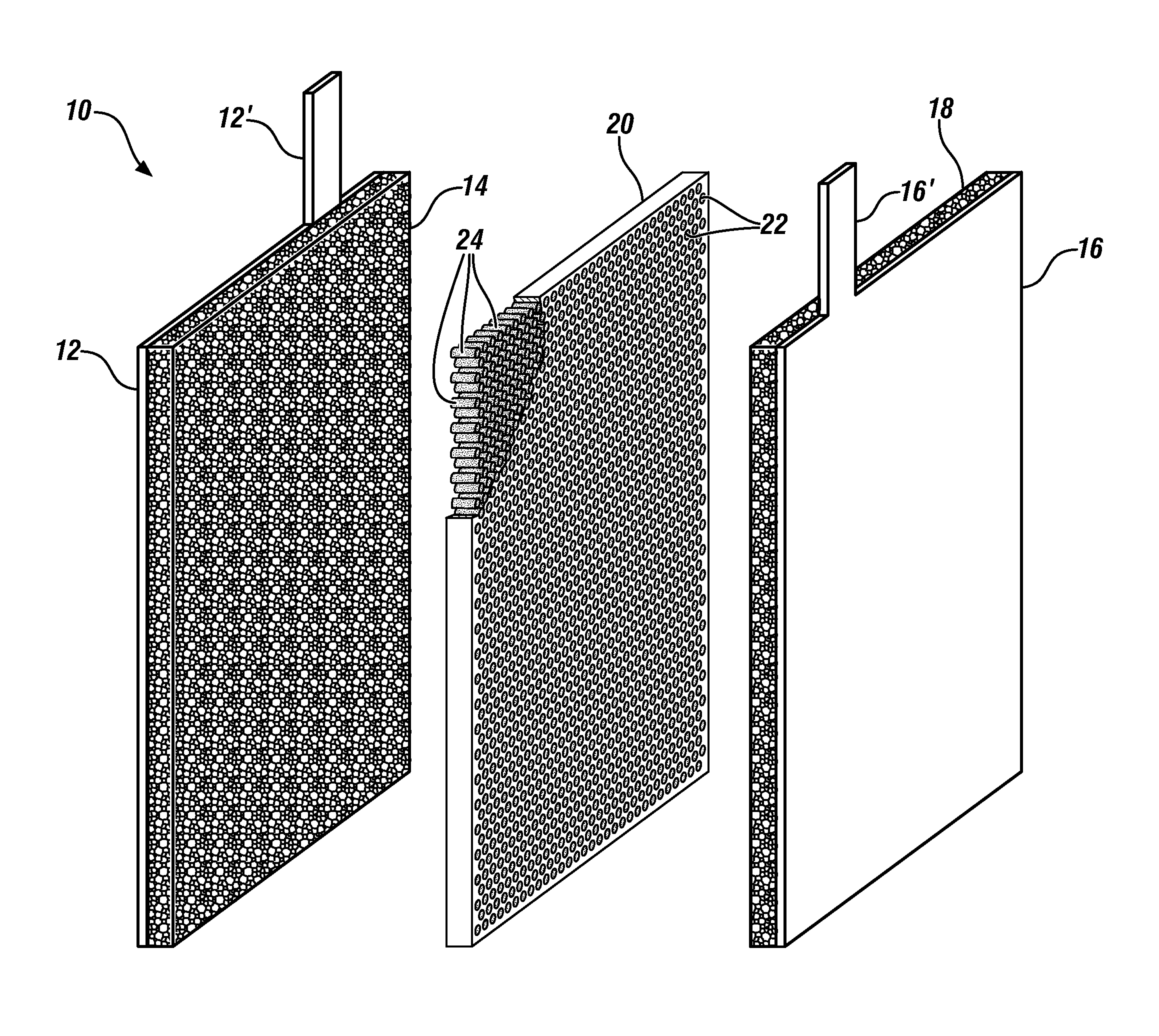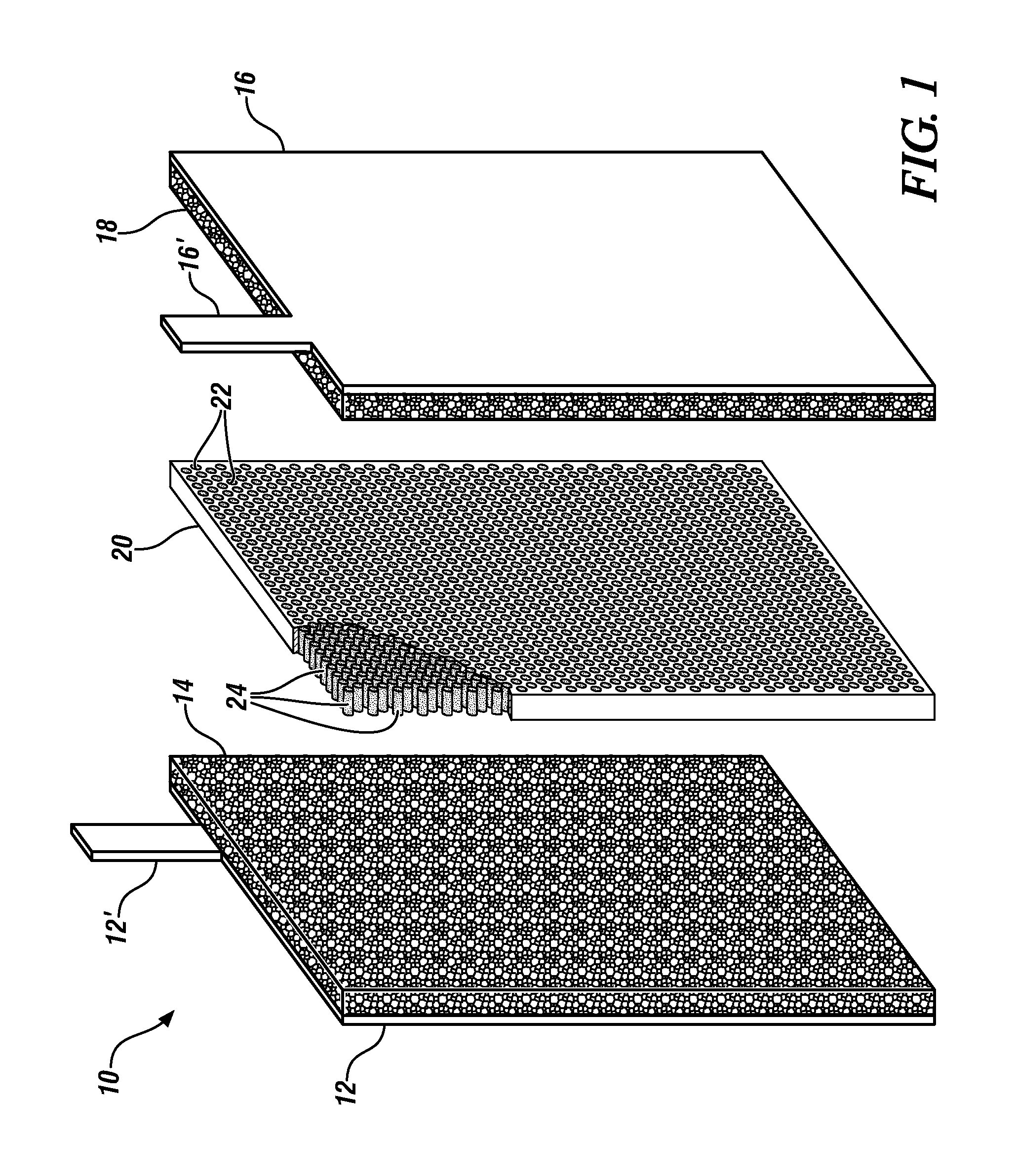Thin and flexible solid electrolyte for lithium-ion batteries
a solid electrolyte, flexible technology, applied in the direction of cell components, final product manufacturing, sustainable manufacturing/processing, etc., can solve the problems of adversely affecting the negative electrode material of graphitic negative electrodes (or other negative electrode materials), and achieve the effect of blocking the transport of transition metal ions and other sei-damaging species
- Summary
- Abstract
- Description
- Claims
- Application Information
AI Technical Summary
Benefits of technology
Problems solved by technology
Method used
Image
Examples
example 1
Screen Printing Process for Ceramic Solid Electrolytes
[0045]Homogeneously blend the selected and prepared ceramic solid electrolyte particles with organic binders (e.g., ethyl cellulose, poly (vinyl alcohol), poly (vinyl butyral), etc.) and a suitable solvent (e.g., alpha terpineol) to prepare a paste. The solid electrolyte layer is formed on a surface of a porous membrane substrate, or into the pores of the substrate, by applying the paste to the substrate using a screen printer, followed by drying and curing at below 200° C. The solid electrolyte coated substrate is co-fired at a desired temperature (200-1100° C.) and in an atmosphere (air, nitrogen, or argon) which depend on the solid electrolyte ceramics.
example 2
Vapor Deposition Coating Process
[0046]Gas phase coating or deposition of solid electrolytes using a variety of techniques including sputtering, plasma spraying, thermal spraying, electrochemical vapor deposition (EVD), chemical vapor deposition (CVD), pulse laser deposition (PLD). Densified pellets of solid electrolytes are used as targets for sputtering and pulse laser deposition processes. Metal-chloride or metal organic compounds (e.g., metal alkoxides) are used as precursors of CVD and EVD. The deposition temperature is controlled to be in a range of 200-1100° C. under various atmospheres, which depends on the selected solid electrolyte ceramic composition.
example 3
Tape-Casting Process
[0047]Prepare electrolyte green tape by mixing electrolyte with binders, plasticizers, and solvents with appropriate ratio to form a suitable slurry. The prepared slurry is spread on a flat surface (a tape surface) with controlled thickness using the doctor blade technique. Thus obtained flexible green tape (with un-fired electrolyte particles) with various thicknesses (thin (˜1 μm) to thick (several hundred micrometers) is cut to size, then gently hot-pressed against the surface of the porous substrate body. The resulting tape-applied, green ceramic composite coating of solid electrolyte particles is co-fired at a suitable, desired temperature (200-1100° C.) and in a suitable atmosphere (air, nitrogen, or argon) to sinter and bond the particles into an electrolyte coating that is impervious to the liquid electrolyte.
PUM
| Property | Measurement | Unit |
|---|---|---|
| diameters | aaaaa | aaaaa |
| diameters | aaaaa | aaaaa |
| thickness | aaaaa | aaaaa |
Abstract
Description
Claims
Application Information
 Login to View More
Login to View More - R&D
- Intellectual Property
- Life Sciences
- Materials
- Tech Scout
- Unparalleled Data Quality
- Higher Quality Content
- 60% Fewer Hallucinations
Browse by: Latest US Patents, China's latest patents, Technical Efficacy Thesaurus, Application Domain, Technology Topic, Popular Technical Reports.
© 2025 PatSnap. All rights reserved.Legal|Privacy policy|Modern Slavery Act Transparency Statement|Sitemap|About US| Contact US: help@patsnap.com



